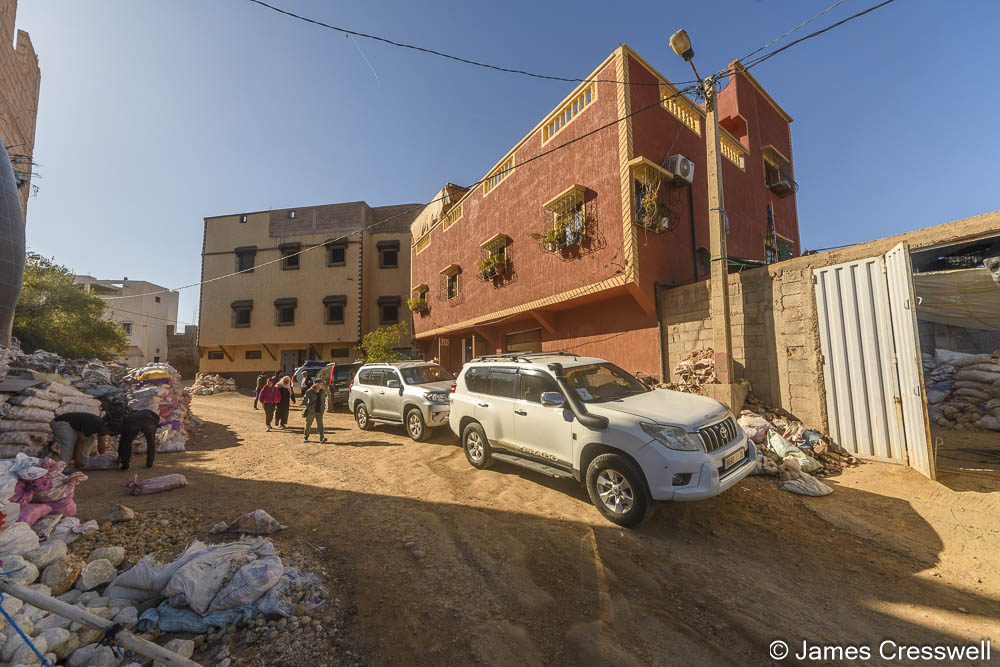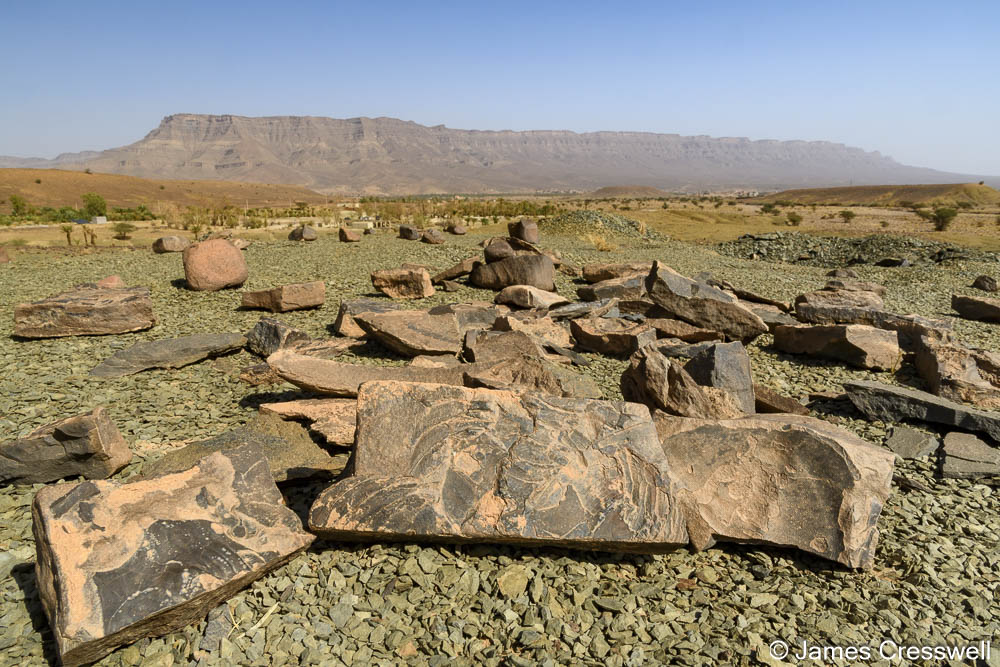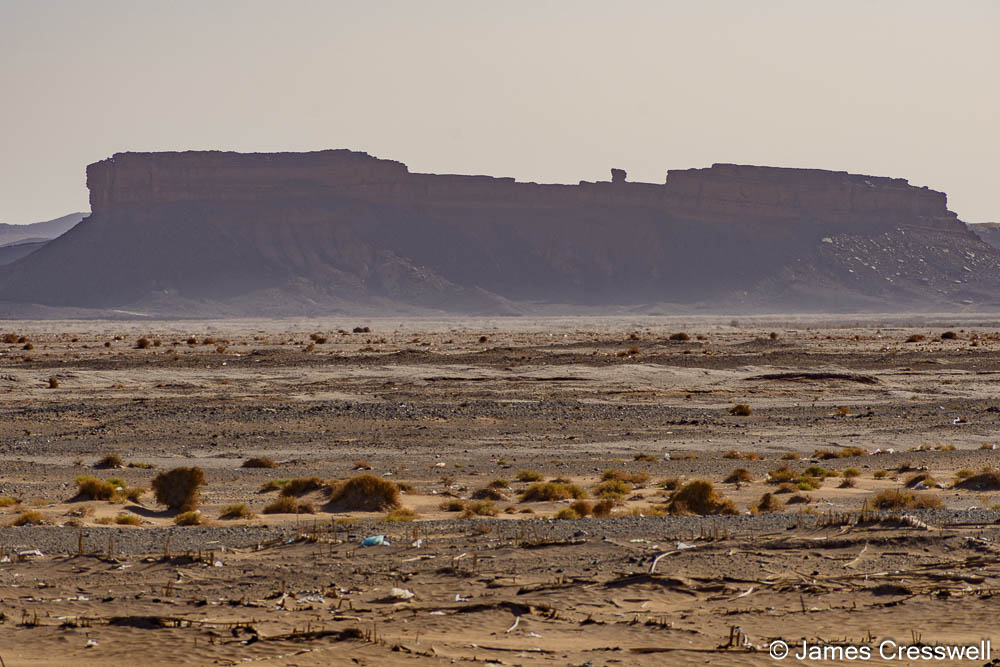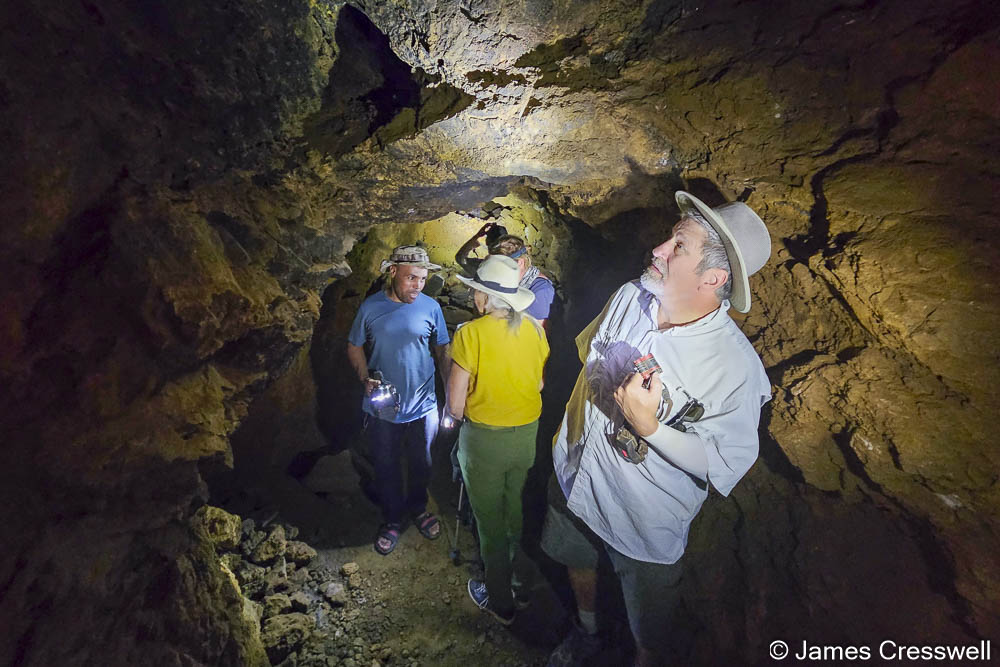November 2023 saw the eighth running of GeoWorld Travel’s “The Trilobite’s Sahara Kingdom” trip to Morocco. We were delighted to welcome guests from the UK, the USA, Germany, Greece and the Netherlands on our latest geological adventure. We followed the same route as in previous years, journeying from Marrakesh, across the High Atlas via Zagora to Merzouga, before returning via the Todra Gorge to Marrakesh to conclude the tour.
Our tour route took us to various fossil and mineral localities, including salt mines and mineral mines, trilobite sites from the Cambrian, Ordovician and Devonian, and dinosaur sites, where numerous teeth and bones have been found. The guests also had a chance to ride a camel in the Erg Chebbi sand dunes, to see the wonderful Ait Ben Haddou World Heritage Site and to explore the enchanting medina and souk of Marrakesh (also a World Heritage Site). As always, we returned from the trip with a huge number of photographs illustrating our adventures, so we have selected our favourites and these are shared below.
Click on photos to enlarge



Above left: Our group’s vehicles parked outside an agate packing warehouse near the Sidi Rahhal agate quarry.
Top right: A view of a faulted contact between Ordovician aged sedimentary rocks in the foreground and Ediacaran aged volcanic rocks in the background, near to the Tizi n Tischka pass, which is the highest point on the main road across the High Atlas Mountains.
Bottom right: Brachiopods in a Middle Cambrian aged breccia seen near the Tizi n Tischka pass in the High Atlas mountains.



Above left: One of the major faults in the High Atlas Mountains. The red coloured rock to the left is Triassic aged rock, while the rock to the right is Ordovician aged. The High Atlas is a transpressional fault system, with both thrust faulting and strike-slip faulting – this fault is an example of the latter.
Top right: Our group walks on a ‘river’ of salt near the Telouet Salt Mine. This image tells the story of the splitting of the Atlantic Ocean. The red-coloured Triassic rocks were deposited in a terrestrial environment, while the dark-coloured basalts were erupted as the Atlantic was rifting, the salt is due to multiple flood and evaporation events during the formation of the Atlantic, and finally the yellow-coloured rocks show that the area had moved to a shallow marine environment. In addition, a watch tower can be seen on top of the middle hill in the background, which dates back many centuries to the time when salt was literally worth its weight in gold.
Bottom right: Ediacaran stromatolites near Ouarzazate, which are 570ma old. They occur in the Ouarzazate volcano-sedimentary supergroup which preserve a record of both explosive volcanic activity and effusive lava flows. The stromatolites grew around the shore of ponds in this volcanically active area. The ponds would have been alkaline because the water became silica rich from passing through volcanic ash.


Above left: A view towards Ouarzazate Solar Power Station (OSPS), also called Noor Power Station, which is the world’s largest concentrated solar power plant. The tower visible in the photo is part of Noor 3, which incorporates mirrors mounted horizontally on platforms which are supported by ten metre columns. Each platform is roughly the size of a tennis court, and the panels follow the light, reflecting it to a 250m tall solar tower.
Above right: The GeoWorld Travel group observe Lower Cambrian aged sediments in a recent road cut near Tizi-n-Tinififft, which is the highest point on the road traversing the Anti Atlas Mountains between Ouarzazate and Agdz.



Above left: View of Jebel Kissane from Agdz. The mountain beautifully shows the Lower Ordovician stratigraphy and, in the foreground, date palms grow in the fertile Draa Valley.
Top right: Members of the GeoWorld Travel group examining discarded trilobite fragments at Oued Slimane. This is located in the lower part of the Fezouata Shale which dates to the Ordovician period, more precisely, the late Tremadocian epoch.
Bottom right: Fragments of giant trilobites discarded by trilobite miners at Oued Slimane.



Above left: The GeoWorld Travel group visit the Ben Moula diggings in the Fezouata Shale Lagerstätte, near Zagora. The Fezouata Shale Lagerstätte is one of the world’s most important fossil sites with exceptional soft-bodied preservation of a fauna that resembles the Cambrian Burgess Shale in Canada.
Top right: A dikelokephalina trilobite from the Fezouata Shale.
Bottom right: A marrellomorph arthropod from the Upper Tremadocian Fezouata Shale.


Above left: Howard points to an outcrop of Silurian-aged limestone which is full of orthoceras fossils at the Serdrar orthoceras quarry.
Above right: The GeoWorld Travel group examining fossil diggings in Middle Ordovician aged rocks near Battou.


Above left: Moroccodiscus smithi, a cyclocystoid echinoderm, found by one of our group, near Battou.
Above right: Giant radiodont arthropod (once known as anomalocarididae) Aegirocassis benmoulae – named after Mohammed Ben Moula who discovered the Fezouata Lagerstätte.


Above left: Trilobite diggings at Jebel Tiskouine. The rocks here are from the Ktaoua Formation of the Upper Ordovician (Katian (Caradoc)). These trilobites are most commonly referred to as Calymenes or ‘mud bugs’, but they are in fact mostly Copocoryphe. This trilobite has been stocked in the fossil shops of the world for over 20 years and 15 million specimens have been sold.
Above right: A calymene or ‘mud bug’ from Jebel Tiskouine.


Above left: A trilobite preparator uses a sand blaster to prepare a Devonian trilobite in Alnif.
Above right: A close-up of a trilobite preparator using a sand blaster to prepare a Devonian trilobite in Alnif.



Above left: The GeoWorld Travel group at Bou Dib on Jebel Issoumour. In the 1970’s and 80’s, Jebel Issoumour became one of the most famous places in the world for early & middle Devonian trilobites. The horizons are mined for several kilometres and are Late Emsian to Early Eifelian in age.
Top right: An assortment of Devonian aged fossils seen at Bou Dib on Jebel Issoumour.
Bottom right: A trilobite miner at El Atchana. The Ihander Formation outcrops here, which is Pragian (Devonian) in age. There are two different fossil horizons which are named after their most famous trilobites: Dicranurus & Kolihapeltis.



Above left: Speeding across the desert to the Mherch oasis.
Top right: The Mherch oasis with the Guelb El Mherch hydrothermal mud mound (or bioherm) in the background. This is a 45m high mound which grew in the Givetian epoch (Devonian period).
Bottom right: View looking away from Mherch.

Above: The Milky Way as seen from Mherch. The lack of light pollution here gives excellent conditions for stargazing.



Above left: Devonian goniatites seen at Jebel El Krabis.
Top right: A distant view of the Eifelian-Givetian global stratotype GSSP (golden spike) from Jebel Amelane.
Bottom right: ‘Erfoud Stone’ – red massive Sphenoclymenia limestone, seen at Jebel Amelane. The stone contains both orthoceras and the ammonoid Gonioclymenia.


Above left: The GeoWorld Travel group in the Erg Chebbi dunes near Merzouga. In places, the dunes of Erg Chebbi rise to 150m high. Altogether they stretch 28km from north to south, and up to 5-7km from east to west.
Above right: A fossil miner looking for dinosaur remains inside a tunnel at the Kem Kem Cretacious-aged fossil beds.


Above left: A box of fossils collected by a local miner in the Kem Kem beds. These beds are Cenomanian (100ma) in age. These beds have revealed over 80 vertebrate taxa including crocodiles, pterosaurs, scherorhynchid sharks, lung fish, bony fish, turtles, snakes, lizards, amphibians. Most famously of all though, they have revealed dinosaurs.
Above right: The Kem Kem beds near Taouz.



Above left: Some of the GeoWorld Travel group inside the Filon 12 Mineral Mine, which started life as a haematite mine. It is now a mine solely for mineralogical specimens and minerals found here include vanadinite, goethite and haematite.
Top right: The GeoWorld Travel group enjoying an evening camel ride in the Erg Chebbi dunes near Merzouga.
Bottom right: The GeoWorld Travel group watching the sun setting over the Erg Chebbu dunes near Merzouga.



Above left: Mary and Graham at Hamar Laghdad (also known as the Kes Kes), which is one of Morocco’s best known Devonian sites. There are forty or more carbonate mounds in a 7km line which formed on a volcano as hydrothermal mud mounds. They have been exposed by erosion and are seen sitting on their palaeo surface. Corals and trilobites used to be abundant but have been heavily collected.
Top right: A tabletop made from Erfoud Stone being polished in an orthoceras factory in Erfoud.
Bottom right: Tables and fossils for sale in the shop of the orthoceras factory of Erfoud.


Above left: The Tahiri Museum near Erfoud
Above right: Inside Brahim’s fossil shop in Alnif



Above left: A Middle Cambrian site near Alnif where the large yellow trilobite, Cambropallas, is found.
Top right: A Cambropallas fossil. Cambropallas is a genus of trilobite in the family Holmiidae.
Bottom right: A major thrust fault seen in Tinghir. The yellower Jurassic-aged rocks are seen thrusting over red Cretaceous-aged rocks. This thrust fault forms a sudden increase in relief and is the start of the High Atlas Mountains.



Above left: The Tohdra Gorge cuts through Jurassic-aged rocks following the line of a fault which can be seen in the middle of this photo.
Top right: The GeoWorld Travel group on a guided tour of Ait Ben Haddou UNESCO World Heritage Site.
Bottom right: Ait Ben Haddou UNESCO World Heritage Site. The site has been fortified since the 11th century, but the current buildings date from the 17th century. This is the most famous ksar in the Ounilla Valley. A ksar is a group of earthen buildings surrounded by high walls and is a traditional pre-Saharan habitat. The site was also one of the many trading posts on the commercial route linking ancient Sudan to Marrakesh by the Dra Valley and the Tizi-n’Telouet Pass.
We hope you have enjoyed the photographs of our latest Moroccan adventure. We will be returning to Morocco next year and beyond – details here: https://www.geoworldtravel.com/morocco.php. Please contact us is you would like to join us in this wonderful Trilobite Kingdom!


